Miami Marlins Rotation: Opening Day 2023

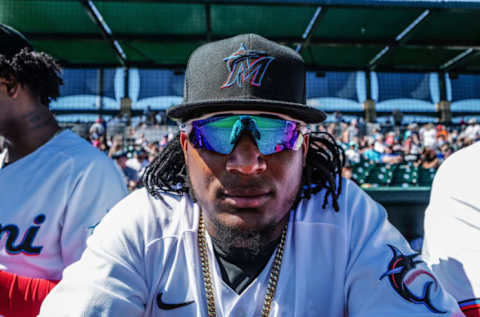
Potential.
It’s a word you hear throughout the Miami Marlins system, from the parent club engaging in major league Spring Training through the lowest rookie-level. There’s a lot more of it now under the new ownership group — led by Bruce Sherman and Derek Jeter — than we’ve seen in some time, coming out from under the auspices of the Jeffrey Loria regime.
This spring will likely see a rotation emerge that mostly resembles the Opening Day rotation of last season. For those who don’t remember, the five to start last season were Sandy Alcantara, Jose Urena, Caleb Smith, Trevor Richards, and Pablo Lopez.
Richards has since been traded away, along with Nick Anderson to the Tampa Bay Rays for major league reliever Ryne Stanek and on-the-verge outfielder Jesus Sanchez. Urena may or may not begin the 2020 campaign in the rotation, but is likely to break camp with the club, at a minimum as a long-relief man.
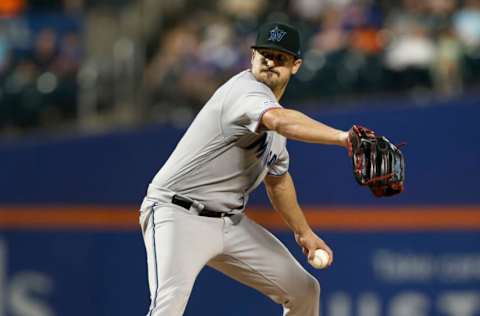
That leaves Smith, Alcantara, and Lopez from last Opening Day, joined by Jordan Yamamoto, who joined the rotation midway through the season and accrued 15 starts. There are several promising candidates for the fifth spot. Robert Dugger, Nick Neidert, Elieser Hernandez, and of course Urena loom as the most likely of those.
Some dark-horse possibilities outside of those four include top overall Miami Marlins prospect Sixto Sanchez along with fellow top-10 system prospect Edward Cabrera. Both seem as if they may be ready to run with the big boys.
But which starters are likely to turn the corner and begin the 2023 campaign as the vaunted “starting five?” It’s a question I asked the wide world of Twitter earlier this afternoon, with varying answers. So who’s going to make the cut? Let’s take a deeper look.

Edward Cabrera is as near a lock to join the Miami Marlins rotation sometime this season that I’ve seen. A six-foot-four, 175 lb. right-hander from Santiago, DR, Cabrera won’t even turn 22-years-old until April. Ranked number six in the system according to MLB Pipeline, Cabrera has a fastball that has reached triple digits, but mostly lives in the 93-to-97 MPH range. He also throws a nasty slider and a solid changeup.
Last season, his fourth in the Miami Marlins system, Cabrera split his time between High-A and Double-A. As part of the Jupiter Hammerheads in the Florida State League through the first half of the campaign, he started 11 games and posted a 5-3 record with a 2.02 ERA, along with 73 whiffs in 58 innings. His 11.3 K/9, 5.7 H/9, and 0.948 WHIP all rated as elite, so the organization pushed him up a level.
https://www.instagram.com/p/B8PS90pg83p/?utm_source=ig_web_button_share_sheet
After joining the Jacksonville Jumbo Shrimp in the Southern League, Cabrera continued his near-mastery of near-major league level talent. Despite being over three years younger than the “average” Southern Leaguer, he racked up a 4-1 record in eight starts, with a 2.56 ERA, 43 K’s in 38 2/3 innings, and a still-near-elite 1.060 WHIP.
Cabrera has done nothing to dissuade Marlins management from their high opinion of him this spring. In two appearances, he has struck out four and surrendered one walk and two hits. Hardly a large enough sample size by which to make a determination as yet, but Cabrera is on path to join the Marlins proper at some point this season. Come 2023, I expect he’ll already be a stalwart in the rotation.
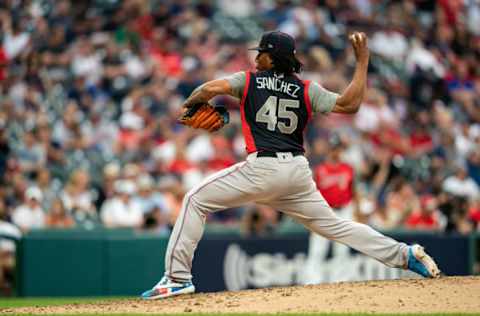
Sixto Sanchez joined the Miami Marlins organization from the Philadelphia Phillies prior to 2019 Spring Training via trade. He came over along with Marlins starting catcher Jorge Alfaro and minor league pitcher Will Stewart for all-star catcher J.T. Realmuto.
Sanchez is a six-foot, 185 lb. right-handed starter from San Cristobal, DR. Boasting both a two- and a four-seam fastball that grades out at 75 on an 80 point scale, Sanchez ranks as the Marlins top overall prospect and as the number 22 prospect in all of baseball, according to MLB Pipeline.
https://www.instagram.com/p/BzuQFI6nzCk/?utm_source=ig_web_button_share_sheet
Along with his top-shelf fastball repertoire, Sanchez also relies on a curveball and a changeup to round out his stable of pitches.
Sanchez throws both a two- and four-seam fastball, the former thrown with a lot of sink to get ground-ball outs and the latter cranked up to triple digits at times. Not only can Sanchez maintain velocity deep into starts, the fastball plays up because of movement and his plus command of the pitch. He can add and subtract from his breaking ball, and seeing it as a future plus strikeout pitch isn’t out of the question. He shows good feel for his changeup as well, giving him the chance to have at least three above-average offerings. — MLB Pipeline
Like Cabrera, Sanchez also split last season between the Hammerheads and the Jumbo Shrimp. In 18 starts at the Double-A level, he posted an 8-4 record and a 2.53 ERA, with 97 strikeouts in 103 innings of work. He dropped a 1.029 WHIP for the Shrimp, walking only 19 batters for a 1.7 BB/9 rate.
Also like Cabrera, Sanchez may make his major league debut with the Miami Marlins in this season. He’ll be part of the rotation until at least 2023.
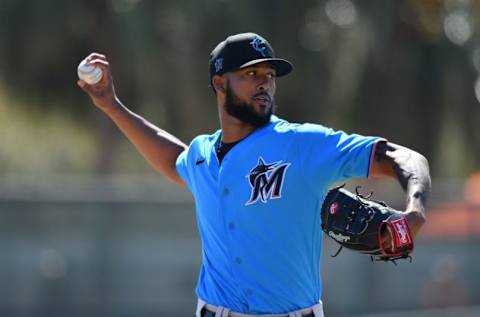
Of the Miami Marlins current starting five, Sandy Alcantara is the likeliest to remain with the club until the 2023 season.
Of the series of trades that “set the table” for future Miami Marlins playoff runs, the Marcell Ozuna deal has stood out as likely the best. Alcantara joined the Marlins system along with Zac Gallen, Magneuris Sierra, and Daniel Castano. Gallen was later flipped for shortstop Jazz Chisholm, speed-demon Sierra remains a possibility to join the club out of camp this season, and Castano is just a season away.
Alcantara is a six-foot-four, 170 lb. right-hander from Azua, DR. Still just 24-years-old, the 2019 Marlins All Star representative is entering his fourth major league campaign. After his middling Marlins debut in 2018 saw him walk 23 batters in only 34 innings, he seemed to have turned the corner in his 2019 campaign.
https://www.instagram.com/p/B8-Uej8gPuI/?utm_source=ig_web_button_share_sheet
Alcantara was 6-14 with a 3.88 ERA for the Miami Marlins last season, leading the National League in losses. He struck out 151 in 197 1/3 innings, along with a 1.318 WHIP and a much-improved 3.7 BB/9.
Sandy is reliant on a five-pitch mix, with a four-seam fastball (30 percent), a sinker (28 percent), a slider (22 percent), a changeup (12 percent) and an occasional curveball (nine percent). His sinker, in particular, resides in the top two percent of the majors in horizontal break vs. average according to Baseball Savant.

Trevor Rogers was the Miami Marlins first round pick back in 2017, with the 13th pick off the board out of Carlsbad HS, in Carlsbad, NM. Still just 22-years-old, Rogers is a six-foot-six, 185 lb. left-handed starter who is ranked eighth in the Marlins now-loaded system. According to MLB Pipeline:
Rogers has an imposing presence at 6-foot-6 and a better fastball than most left-handed starters, working at 92-94 mph and touching 96 with deception and command. His advanced age for a high schooler and his lack of feel to spin a breaking ball concerned some clubs in the 2017 Draft, and the latter remains an issue because he has trouble staying on top of his curveball and it tends to blend together with his slider. His tumbling changeup also lacks consistency but could be his best secondary pitch in the long run.
After getting selected, Rogers took the rest of 2017 off. In 2018, he started 17 games for the Single-A Greensboro Grasshoppers in the South Atlantic League, and posted a 2-7 record with a 5.82 ERA. He posted a concerning 1.555 WHIP, but still managed to whiff 85 batters in 72 2/3 innings.
Rogers took the step to High-A last season with the Hammerheads, and did not disappoint with his progress. He was 5-8 with a 2.53 ERA in 110 1/3 innings. He struck out 122 and got his WHIP way down to 1.097. Most impressively, he walked only 24 for a K/BB over five. In five starts one step up with the Jumbo Shrimp, he struck out 28 in 26 innings and posted a 1.308 WHIP.
Rogers is still at least a season away, and this number four projection for the 2023 campaign could as easily go to stable-mate Braxton Garrett. For my money, I think Rogers has the higher ceiling.
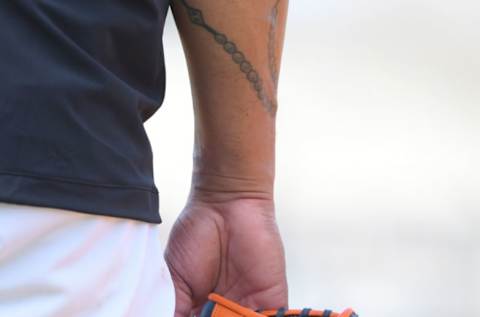
This may be a little bit of putting the cart before the horse, but the Miami Marlins have the third overall pick in the 2020 MLB Amateur Entry Draft. I believe they’ll spend that pick on Emerson Hancock.
Hancock is a six-foot-four, 213 lb. right-handed starter from Cairo, GA. Still just 20-years-old, Hancock is in his third season pitching with the University of Georgia Bulldogs. In 29 starts, he’s posted a 14-7 record with a 3.43 ERA and 172 whiffs in 168 frames. He’s held the opposition to a 1.071 WHIP.
Most impressive so far for Hancock was his 2019 UGA season. He was 8-3 with a 1.99 ERA, 97 K’s in 90 1/3 innings and a 0.841 WHIP over 14 starts.
Kate Preusser over at Lookout Landing had a pretty good report on Hancock:
More from Marlins News
- Miami Marlins are pursuing Michael Conforto
- Miami Marlins need to spend to win
- Miami Marlins can’t afford to botch this trade
- Miami Marlins news: the New York Mets are a risky threat
- Miami Marlins keep missing out on stars
Hancock lives on his fastball, but he also has an arsenal of other pitches that project to be above-average offerings, including a slider, changeup, and curveball. The slider is probably the most advanced of the secondaries, with sweep and sink that makes it disappear on batters, but Hancock says he feels his curveball is one of the pitches that’s taken the biggest step forward with his added muscle, as he feels like he’s getting tighter spin on it.
I believe that the two-and-a-half seasons following the 2020 draft will be sufficient to prepare Hancock for major league ball, and he should start the 2023 campaign in the Marlins rotation.
Of course, this was after all a thought-exercise. The Miami Marlins have a lot of other possibilities in-system, and countless more through draft, trade, free agency, and rule 5. What do you think? Am I way off? Let me know in the comments, whether you agree or disagree, and thanks for reading.
Jordan Holloway Could Join Marlins Rotation Soon. dark. Next